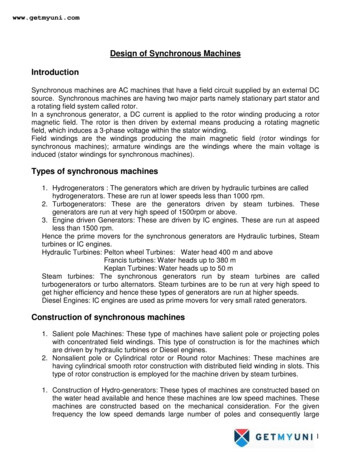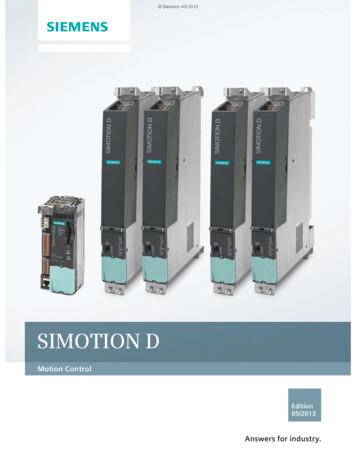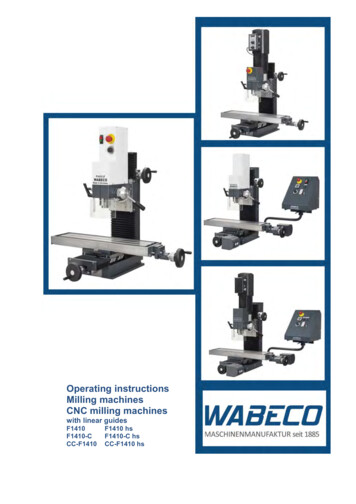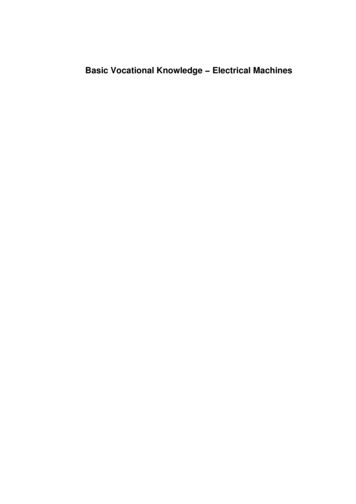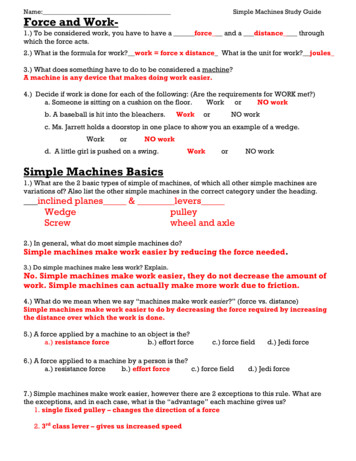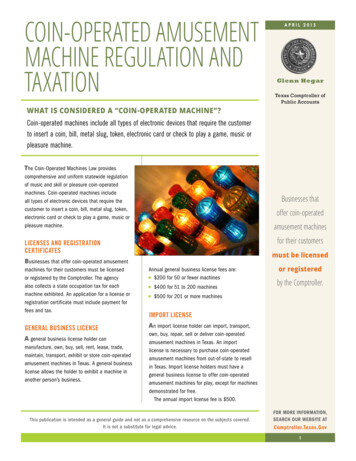
Transcription
Introduction to Virtual Machines IntroductionAbstraction and interfacesVirtualizationComputer system architectureProcess virtual machinesSystem virtual machinesEECS 768 Virtual Machines1
Abstraction Mechanism to manage complexity in computersystems. Mechanism consists of– partition the design of a system into levels– allow higher levels to ignore the implementationdetails of lower levels In computer systems, lower levels areimplemented in hardware, and higher levels insoftware.EECS 768 Virtual Machines2
Interfaces An interface defines the communicationboundary between two entities– hierarchical relationship– linear relationship Software can run on any machine supporting acompatible interfaceMacIntosh apps.MacOSPowerPCWindows apps.Windowsx86EECS 768 Virtual MachinesLinux appsLinuxx863
Interfaces – Advantages Allows de-coupling of computer design tasks– each component provides an abstraction of itself to theoutside world Work on different components can progressindependently Helps manage system complexityEECS 768 Virtual Machines4
Interface – Disadvantages Software compiled for one ISA will not run onhardware with a different ISA– powerPC binaries on an x86 machine ? Even if ISA's are same Oses may differ– MS–Windows applications Sun Solaris ?MacIntosh appsMacOSx86Windows apps.Linuxx86EECS 768 Virtual Machines5
Interface – Disadvantages (2) Binaries may not be optimized for the platformthey run on– Intel Pentium binaries on AMD Athlon ? Innovation may be inhibited by a fixed ISA– hard to change instruction sets Application software cannot directly exploitmicroprocessor implementation features– software supposed to be implementation-neutral !EECS 768 Virtual Machines6
Virtualization Removes some constraints imposed by systeminterfaces, and increases flexibility– improves availability of application software– removes the assumption of a single managementregime, improving security and failure isolation Provide a different view to a particular computerresource– not necessarily a simpler viewEECS 768 Virtual Machines7
Virtualization (2) Virtualization constructs an isomorphism thatmaps a virtual guest system to a real host.e(Si )SiSjGuestV(Si )V(Sj )e'(Si')Si'Sj'HostEECS 768 Virtual Machines8
Virtualization (3) Virtualization Vs. abstraction– virtualization does not necessarily hide detailsvirtualizationfilefileEECS 768 Virtual Machines9
Virtual Machines Concept of virtualization applied to the entiremachine. A virtual machine is implemented by adding alayer of software to a real machine to supportthe desired virtual machine’s architecture. Virtualization– mapping of virtual resources or state to realresources– use of real machine instructions to carry out actionsspecified by the virtual machine instructionsEECS 768 Virtual Machines10
Some Benefits of VMs FlexibilityPortabilityIsolationSecurityEECS 768 Virtual Machines11
Computer System Architecture Architecture – functionality and appearance of acomputer system, but not the details of itsimplementation Implementation – the actual embodiment of anarchitectureEECS 768 Virtual Machines12
Computer Architecture (2)Software Computer systems arebuilt of levels ofabstraction– hierarchical abstraction– well-defined interfacesApplicationProgramsLibrariesOperating SystemDriversMemoryManagerSchedulerExecution HardwareSystem ollersI/O devicesandNetworkingMainMemoryHardwareEECS 768 Virtual Machines13
The ISA Interface Interface betweenhardware and software Important for– OS developerApplicationProgramsLibrariesOperating SystemExecution HardwareSystem Interconnect(bus)I/O devicesandNetworkingEECS 768 Virtual MachinesMemoryTranslationMainMemory14
The ABI Interface Application BinaryInterface (ABI)ApplicationProgramsLibraries– user ISA system calls Important forOperating System– compiler writersExecution HardwareMemoryTranslationSystem Interconnect(bus)I/O devicesandNetworkingEECS 768 Virtual MachinesMainMemory15
The API Interface ApplicationProgrammingInterface (API)– user ISA library callsApplicationProgramsLibrariesOperating SystemExecution Hardware Important for– applicationprogrammersMemoryTranslationSystem Interconnect(bus)I/O devicesandNetworkingEECS 768 Virtual MachinesMainMemory16
Major Program Interfaces ISA – supports all conventional softwareSystem CallsApplication SoftwareOperating SystemSystem ISAUser ISAISA ABI – supports application software onlyApplication SoftwareSystem CallsOperating SystemSystem ISAUser ISAEECS 768 Virtual MachinesABI17
Process Virtual Machines Process virtual machine is capable ofsupporting an individual process– different guest and host ISA– couple at ABI level via runtime systemGuestApplication HostApplication ProcessMachineHardwareEECS 768 Virtual Machines18
Process Virtual Machines (2) Constructed at ABI level Runtime manages guest process Runtime communicates withhost OS Guest processes mayintermingle with host processes As a practical matter, binariesbuilt for same OS Dynamic optimizers are aspecial case Examples: IA-32 EL, T OSfile sharingEECS 768 Virtual MachinesDisknetwork communication19
System Virtual Machines System Virtual Machine capable of supportingan OS with potentially many user processes– couple at ISA level– eg., IBM VM/360, VMWare, Transmeta zingSoftwareHostHardware"Machine"EECS 768 Virtual MachinesVirtualMachine20
PVM – Multiprogramming PVM provided by a multi-process OS for eachconcurrently executing application. Combination of the OS system call interface,and the user-level ISA. Each process is given the illusion of having thecomplete machine to itself.EECS 768 Virtual Machines21
PVM – Emulators Execute binaries compiled to a differentinstruction set than that executed by the host’shardware. Interpretation– low startup overhead– high steady-state per instruction emulation overheadEECS 768 Virtual Machines22
PVM – Dynamic Translators Run-time translation of blocks of sourceinstructions to equivalent target instructions.– high start-up translation overhead– fast steady-state execution Uses a code cache tostore translated blocksof code for reuse. e.g., Digital’s FX!32system, Aries system,Intel IA-32 EL systemEECS 768 Virtual MachinesHP AppsUNIXHP PA23
PVM – Same ISA Binary Optimizers Same source and target ISAs. Main task is the optimization of the sourcebinary– ABI level optimization– may also collect performance profiles– may also enhance security e.g., Dynamo system, developed at HewlettPackard.EECS 768 Virtual Machines24
PVM – High Level Language VM A HLL is designed for VM execution– minimize hardware-specific and OS-specificfeatures that could compromise portabilityHLL ProgramCompiler front-endIntermediate CodeCompiler back-endHLLProgramCompilerPortable Code(Virtual ISA )VM loaderObject Code(ISA)Virt. Mem. ImageVM Interpreter/TranslatorLoaderMemory ImageHost InstructionsTraditionalHLL VMEECS 768 Virtual Machines25
PVM – High Level Language VM Binary class files are distributed– ISA part of class file (no real implementation) OS interaction via API e.g., Java, Microsoft CLIJava Binary ClassesJava plementationSparcWorkstationx86PCAppleMacEECS 768 Virtual Machines26
Classic System Virtual Machine Original meaning of the term virtual machine– all guest and host software use the same ISA– VMM runs on bare hardware (most privileged mode)– VMM intercepts and implements all the privilegedoperations for the guest OS.WinWinprocess processWinprocessLinuxLinuxLinuxprocess process processGuest OS2 (Linux)Guest OS (Windows)VMMHOST PLATFORMvirtualnetwork communicationEECS 768 Virtual Machines27
Hosted System Virtual Machine Virtualizing software is built on top of anexisting host OS. Advantages– installation is like installing application programs– host OS provides device driver support Drawbacks– less efficientEECS 768 Virtual Machines28
Whole System VMs Different ISA for guest and host systems.– both application and OS code require emulation Implemented by placing the VMM and theguest software on top of a conventional host OSrunning on the hardware e.g., Virtual PCEECS 768 Virtual Machines29
Codesigned Virtual Machines VMs designed to enable innovative ISAs and/orhardware implementations for improvedperformance, power efficiency, etc. Similar hardware virtualization is common formicroprocessors, such as Pentium IV. Software VM is part of the hardware design– applications/OS never directly execute native ISAinstructions e.g., Transmeta Crusoe processorEECS 768 Virtual Machines30
VM TaxonomyProcess VMssame namoSystem VMsdifferentISADynamicTranslatorsIA-32EL, FX!32same ISAClassic SystemVMIBM VM/370Hosted VMHLL VMVMwareJava VMMS CLIdifferentISAWhole SystemVMVirtual PC for MacCodesignedVMTransmetaCrusoeEECS 768 Virtual Machines31
Concept of virtualization applied to the entire machine. A virtual machine is implemented by adding a layer of software to a real machine to support the desired virtual machine's architecture. Virtualization -mapping of virtual resources or state to real resources -use of real machine instructions to carry out actions

